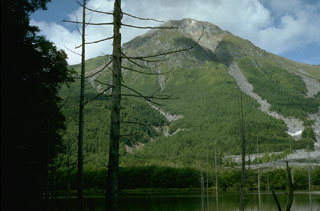Report on Yakedake (Japan) — 6 July-12 July 2022
Smithsonian Institution / US Geological Survey
Weekly Volcanic Activity Report, 6 July-12 July 2022
Managing Editor: Sally Sennert.
Please cite this report as:
Global Volcanism Program, 2022. Report on Yakedake (Japan) (Sennert, S, ed.). Weekly Volcanic Activity Report, 6 July-12 July 2022. Smithsonian Institution and US Geological Survey.
Yakedake
Japan
36.227°N, 137.587°E; summit elev. 2455 m
All times are local (unless otherwise noted)
JMA reported that after an increase in the number of small volcanic earthquakes with epicenters near Yakedake’s summit in late May, seismicity remained elevated for a few weeks. Seismicity decreased in mid-June and returned to baseline levels. The Alert Level was lowered to 1 (on a scale of 1-5) on 12 July.
Geological Summary. Yakedake rises above the popular resort of Kamikochi in the Northern Japan Alps. The small dominantly andesitic stratovolcano, one of several Japanese volcanoes named Yakedake or Yakeyama ("Burning Peak" or "Burning Mountain"), was constructed astride a N-S-trending ridge between the older volcanoes of Warudaniyama and Shirataniyama. Akandanayama, about 4 km SSW, is a stratovolcano with lava domes that was active into the Holocene. A 300-m-wide crater is located at the summit, and explosion craters are found on the SE and N flanks. Frequent small-to-moderate phreatic eruptions have occurred during the 20th century. On 11 February 1995 a hydrothermal explosion in a geothermal area killed two people at a highway construction site.

